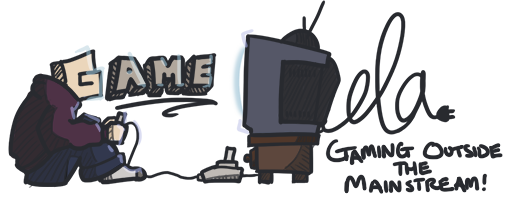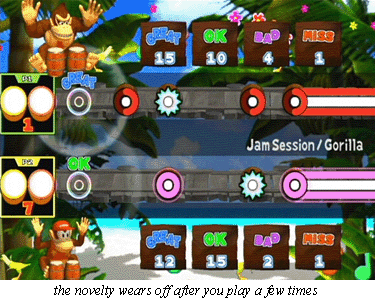Nintendo recently entered the rhythm game scene with a unique title of its own. That title is Donkey Konga, a game where songs are played with a mini bongo set (which can either be bought with the game or separately). On this bongo set, beats are hit out as they come out on the screen, and claps are made to hit certain beats.
The concept is basically what was stated above, to hit the beats. After completing songs, coins are awarded for hitting the right beats and those can then in turn be used to buy more songs. It may sound boring, but it’s worked for other games right? Well, not in this game. Playing Donkey Konga is exciting at first, especially if the player is a fan of rhythm games, but after playing through and unlocking all the songs it’s boring. The idea of hitting a bongo controller may seem fun in theory, but after playing the game a couple of times, the novelty really wears off.
Donkey Konga has only thirty-three songs, and that is a definite negative for the game, even though a lot of the music is of different genres. Those genres range from techno (The Crystal Method), to ska (The Mighty Mighty Bosstones), to classical (Hungarian March). The oddest thing and almost negative thing I found of the music was it was all covered except for the official Nintendo music.
Visually, the game is nothing great; average graphics are used throughout the menus and characters. A lot of the visuals that are seen are the colors red, yellow, pink, and blue, the colors of the beats that are supposed to be hit on screen. Even though it’s arguable that rhythm games don’t need good graphics, games like Dance Dance Revolution and Amplitude provide an interesting thing to do or watch while playing the actual rhythm game.
The controls of this game are quite simple: hit the bongos on certain beats and clap on others. It gets boring and repetitive fast. With only three different “hit types” there is only so much variation that can be had. There was an interesting part about the controls for awhile, the idea of clapping for certain beats; well, the game picks up tapping on the microphone as clapping, and also blowing on it, and clicking one’s tongue and—that’s a whole game in itself, but that gets boring too.
I didn’t find this game very fun after playing it the first couple of times. Although there are minigames and multiplayer “battles,” they are just too simple to actually be fun. Another mode was made to make the game more fun, called “Monkey Jam,” where the notes need to be memorized to play that mode; well, I bet no one ever plays that mode since the game actually needs to be played to memorize things. In saying that, I would say Donkey Konga has a low replay value since it goes from fun to boring real fast.
I do give Nintendo a thumbs up for attempting to broaden its scope, but I give it a thumbs down for copying the idea from Namco’s Taiko: Drum Master and also trying to put characters from one of its popular and well respected game series to try and get people to buy it. Just because Donkey Kong is on the box and in the name does not mean it’s good. I say that as fair warning for all games; don’t be like me and buy this game expecting a lot. In fact, when I bought it, the person who sold it to me actually said, “Wow, someone is actually buying this.” Think about it.

